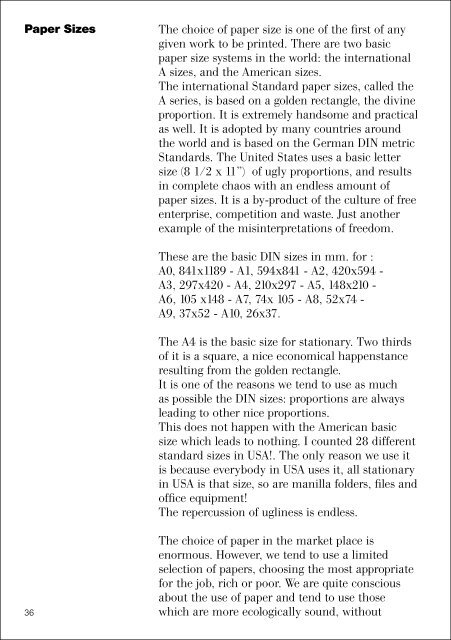1jyF4uV
1jyF4uV
1jyF4uV
Create successful ePaper yourself
Turn your PDF publications into a flip-book with our unique Google optimized e-Paper software.
Paper Sizes36The choice of paper size is one of the first of anygiven work to be printed. There are two basicpaper size systems in the world: the internationalA sizes, and the American sizes.The international Standard paper sizes, called theA series, is based on a golden rectangle, the divineproportion. It is extremely handsome and practicalas well. It is adopted by many countries aroundthe world and is based on the German DIN metricStandards. The United States uses a basic lettersize (8 1/2 x 11”) of ugly proportions, and resultsin complete chaos with an endless amount ofpaper sizes. It is a by-product of the culture of freeenterprise, competition and waste. Just anotherexample of the misinterpretations of freedom.These are the basic DIN sizes in mm. for :A0, 841x1189 - A1, 594x841 - A2, 420x594 -A3, 297x420 - A4, 210x297 - A5, 148x210 -A6, 105 x148 - A7, 74x 105 - A8, 52x74 -A9, 37x52 - A10, 26x37.The A4 is the basic size for stationary. Two thirdsof it is a square, a nice economical happenstanceresulting from the golden rectangle.It is one of the reasons we tend to use as muchas possible the DIN sizes: proportions are alwaysleading to other nice proportions.This does not happen with the American basicsize which leads to nothing. I counted 28 differentstandard sizes in USA!. The only reason we use itis because everybody in USA uses it, all stationaryin USA is that size, so are manilla folders, files andoffice equipment!The repercussion of ugliness is endless.The choice of paper in the market place isenormous. However, we tend to use a limitedselection of papers, choosing the most appropriatefor the job, rich or poor. We are quite consciousabout the use of paper and tend to use thosewhich are more ecologically sound, withoutcompromising the end result.For stationary we like to use a heavy paper (100%cotton - sub 28) for executive level, and a regularbond for business level. Same paper for theenvelopes, usually with a square flap. Size mayvary according to countries.For books, it depends very much on the kind ofbook. For text books, we use a book paper; forillustrated books we will use a coated, dull orglossy according to the subject, although we tendto prefer dull papers. The quality of reproductioncontinues to improve, better papers, better inks,better printing presses, better technologies.The field is in continuos motion and we have tokeep up with the times. Every technology impliesdifferent production costs and we should be awareand work with the suppliers to optimize costs andquality. Not all the countries share the same levelof printing quality and we have to try to obtain thebest in every situation.Not all papers are available around the world andthat sometime poses some quality problems.Whenever possible, we like to use both sides of asheet of paper, even when we do posters, offeringthe possibility of increasing and pacing theinformation on a large piece of paper, rather thanwasting one side.The most common poster sizes in Europe are:50x70, 70x100, 100x140 centimeters.More poster sizes are available in the USA.In designing a book, a brochure, or any otherkind of printed matter, the choice of the paper sizeinvolves quite a complexity of issues. Sometimesit has to conform to previous related publications,sometimes it has to break a new ground,sometimes the size itself becomes the carrier of amessage even before anything is printed on it.The choice of a size is a very important decision.It involves costs and is part of the overall economyof the production process. It is important that


